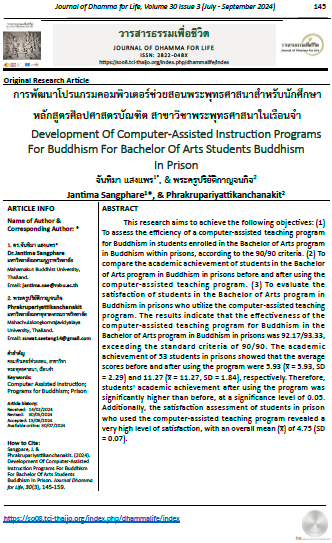Development Of Computer-Assisted Instruction Programs For Buddhism For Bachelor Of Arts Students Buddhism In Prison
Main Article Content
Abstract
This research aims to achieve the following objectives: (1) To assess the efficiency of a computer-assisted teaching program for Buddhism in students enrolled in the Bachelor of Arts program in Buddhism within prisons, according to the 90/90 criteria. (2) To compare the academic achievement of students in the Bachelor of Arts program in Buddhism in prisons before and after using the computer-assisted teaching program. (3) To evaluate the satisfaction of students in the Bachelor of Arts program in Buddhism in prisons who utilize the computer-assisted teaching program. The results indicate that the effectiveness of the computer-assisted teaching program for Buddhism in the Bachelor of Arts program in Buddhism in prisons was 92.17/93.33, exceeding the standard criteria of 90/90. The academic achievement of 53 students in prisons showed that the average scores before and after using the program were 5.93 (x̅ = 5.93, SD = 2.29) and 11.27 (x̅ = 11.27, SD = 1.84), respectively. Therefore, students' academic achievement after using the program was significantly higher than before, at a significance level of 0.05. Additionally, the satisfaction assessment of students in prison who used the computer-assisted teaching program revealed a very high level of satisfaction, with an overall mean (x̅) of 4.75 (SD = 0.07).


